This article took much longer to research than I thought it would.
I knew that having a HEPA filter doesn’t mean much (more on that later), but I underestimated how many “points” there are where a vacuum for allergies can mess up. The problem with allergies and vacuum is if you have one “kink in the chain,” it ruins the whole sealed HEPA system.
The purpose of this article is to cover the entire “chain.” You’ll learn:
- why HEPA filters can just be marketing hype
- “fail points” in many vacuums and why you need a sealed system
- bagged vs bag vacuums for allergies
- important tips on vacuum power, beater bars, and emptying your vacuum
- which certifications matter (and how to start a shady business)
- best vacuums for allergies (click here to see my top 3 picks)
- best HEPA vacuum bags
But before we dive into the boring details, let’s cut to the chase. After all of this research, these vacuums are my favorites for allergies:
Vacuum filters and allergies: HEPA, marketing hype, sealed systems, and more
Let’s start with the elephant in the room: HEPA filters.
I love HEPA filters because they are extremely effective. I hate HEPA filters because sometimes they are used as a marketing trick. Let’s dive into what HEPA filters are and then the problems you can run into:
What is a HEPA filter? A HEPA filter is defined by filtering out 99.97% of particles that are 3 microns or larger. Let’s put this in perspective:
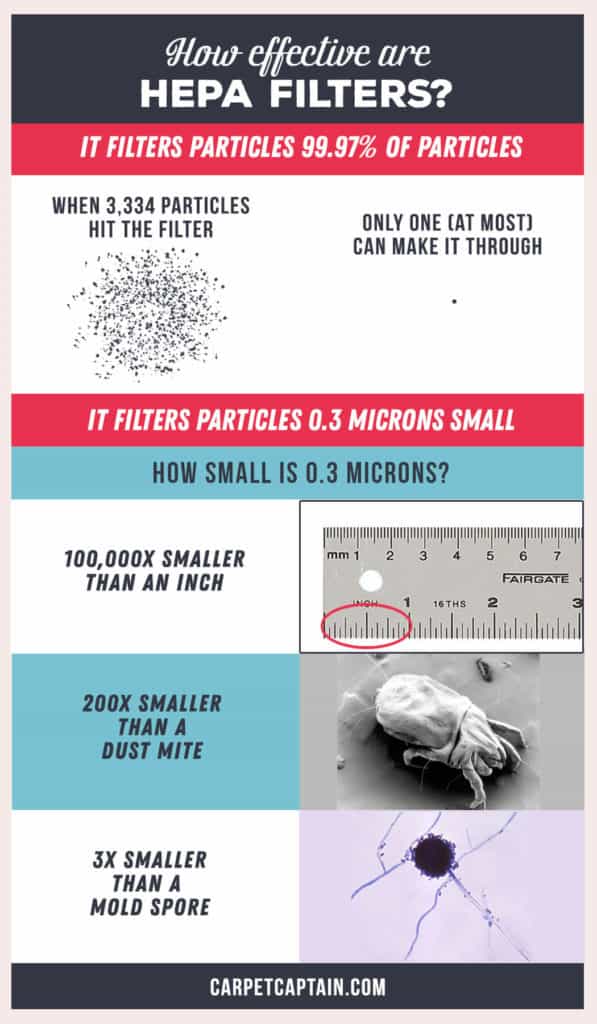
What does this image show specifically?
- 1 in every 3,333 particles can make it through the filter (at most–less probably make it through)
- it filters particles much smaller than dust mites and mold spores (2 big allergy offenders!)
So bottom line, HEPA basically guarantees your filter will clean your air of any allergens that pass through it. Remember, these are minimums for a HEPA filter. In reality, it likely filters smaller and more particles.
So if HEPA filters are so good, what’s the problem with them?
Why the best filters are sometimes worthless (hint: you need a sealed system)
Let’s pretend you buy a vacuum with a new state-of-the-art filter that lets 0 particles through. Sounds amazing.
But you run your vacuum and start sneezing like crazy. What’s going on?
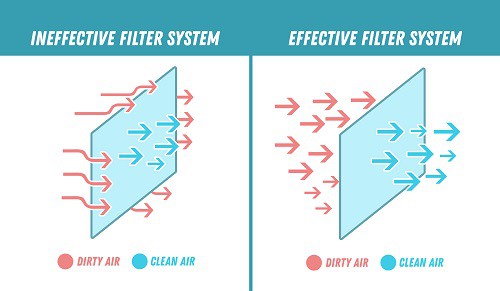
The vacuum doesn’t have a sealed system. In other words, the air isn’t pushed through the filter. It’s escaping around the filter. Think if you have a water filter pitcher but holes that leak water from the top chamber into the bottom. The filters now worthless.
That same idea happens with vacuums. Sometimes air escapes out of microscopic “cracks” where the vacuum plastic is sealed together. More likely, the air might get around the “seal” of the filter. This means it is blown out of the vacuum where it should but never made it through the filter.
So how do you make sure your vacuum doesn’t leak? Some will specifically list that they are a “sealed system.” This means they have been designed not to have leaks and air is required to go through the filter. If they don’t list this, it can be difficult to determine. One way to do it would be to check the seals around the filter and make sure they seem airtight. Then, turn the vacuum on and feel around the vacuum to make sure air isn’t escaping anywhere but the exhaust.
I think this video by Dyson does a good job showing the difference in a sealed vs non-sealed system (this isn’t a plug for Dyson, but I just think this video is a neat demonstration):
Is a HEPA filter necessary for allergies?
The short answer: yes. The long answer is technically no, you don’t need a HEPA filter…
A filter could fail HEPA certification could and still remove 99.9% of particles smaller than a mold spore! That’s not going to be noticeable to even a severe allergy sufferer!
That’s why technically I see HEPA as a requirement.
But here’s the reality: if it’s not labeled HEPA, I don’t know how good the filter is. It could be nearly HEPA level, or it could be no better than my sock. The other problem is if the vacuum isn’t going the “extra mile” to have a HEPA filter it’s doubtful it has a sealed system.
So bottom line for allergy sufferers: I’d make sure your vacuum has a HEPA filter.
Bagged vs bagless for allergies
Remember our picture above on how small dust mite poop and mold spores are? To give it more perspective, these microscopic particles causing sneezing and running noses can shoot straight through a vacuum bag.
That’s hard for me to believe! But it’s true. This means your bagged vacuum may not be the best for allergies. However, bags do provide one advantage:
Emptying.
Most bagless vacuums cause a poof of allergens when you empty it. Bagged vacuums, especially those designed for allergies, can be thrown away without much or any dust release. This is a big win for bagged vacuums.
What about HEPA bags?
If you have a bagged vacuum you like, don’t be disappointed. It may not filter out allergens like the best bagless vacuums for allergies, but with a slight modification, it can be the best vacuum for allergies.
You can buy premium HEPA bags for allergies. This will make sure no dust mites are making it through your bag. This way you get the benefit of a HEPA filter combined with the bags cleaner emptying of the vacuum. Best of both worlds.
More suction = more allergens removed
To this point, we’ve focused on making sure your vacuum isn’t leaking out the allergens it sucks up. That’s great, but it’s worthless if your vacuum doesn’t suck up the allergens off your carpet and upholstery in the first place.
There’s a big difference in vacuums cleaning ability, particularly with carpet. If you have a carpeted home, it’s worth checking out our vacuum recommendations to make sure you get one that removes the most dust and debris.
Accessories that make a difference for allergies
I don’t think much of accessories when I buy a vacuum, but there are a few that can make a big difference for allergies sufferers. You don’t need anything fancy, but I’d make sure your vacuum has highly-rated upholstery cleaning tool (after all, allergens like your couch, too). One other accessory you might look for is a handheld brush that can be used on blinds, table tops, and other surfaces. You can clean these with other tools, but you may clean them more often if your vacuum can do it.
Is a beater bar necessary for allergies?
I always recommend cleaning with the beater bar when possible. New beater bars do a great job of picking up and loosening debris that may not come clean with suction alone. That said, some carpet can be damaged by beater bars, this is particularly true with Berber. In these cases, you’ll either need a beater bar that can turn off or the ability to manually adjust the height of your vacuum, so the beater bar is just skimming the top.
Emptying the vacuum is a big trigger point for allergies
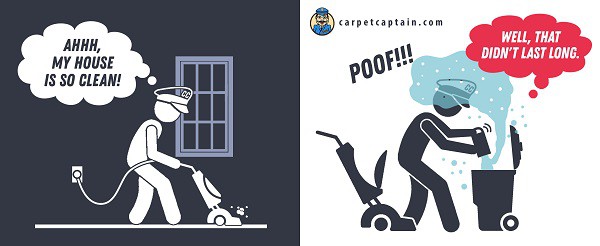
I touched on this earlier, but emptying your vacuum can ruin even the best vacuum for allergies ability to get your house clean.
Most bagless vacuums you empty will puff up a cloud of dust when it hits the trash can. Now, you’re covered in allergens and the allergens you just sucked up are blowing around your home.
What’s the best way to avoid this:
- Empty the vacuum outside (this is most important)
- Have a person without allergies be the one to empty it (it’s hard to avoid any dust getting on you)
That may not be a groundbreaking tip but one many allergy sufferers leave out.
Your other option is using a bagged vacuum but upgrading your bag (see above).
Do certifications matter? How to start a shady business
Want a quick, easy, and shady way to make money? Here’s how you do it:
- Start a business with an official sounds name for allergies “the allergy equipment certification company”
- Make a test for vacuums that relates to allergies but is very easy to pass “dump a cup of dirt/dust on the ground if the vacuum picks up 50% it passes”
- Reach out to vacuum manufacturers and tell them you have a test you believe their vacuum can pass. They can send you $100 and you will test their vacuum for certification.
- They send you $100. You test their vacuum, and let them put “certified by the allergy equipment certification company” on their marketing.
- They sell more vacuums for allergies. You’re $100 richer.
Please, don’t start this business. But the point is, a vacuum being certified means nothing. You have to research the company and process doing the certification.
There is one certification company for vacuums that I trust: the Asthma and Allergy Foundation of America. It is a nonprofit designed to provide research, advocacy, and education for asthma and allergy sufferers as well as healthcare workers. They have a specific rigorous certification for vacuum emissions. Vacuums that pass get this seal of certification:
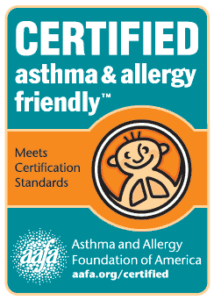
If you see this, I trust that the vacuum has a great filtering system (likely sealed with a HEPA filter). However, it’s not a guarantee of the vacuum overall performance, but hopefully, this article helped.
2 unconventional vacuum systems worth mentioning
Neither of these is one of my top vacuums for allergies, but only because I haven’t personally tried it out. However, the technology behind them seems like they could be a good option for some people, so I wanted to at least mention these 2 vacuum systems:
Rainbow vacuums and central vacuum systems.
Rainbow vacuums are a do-it-all vacuum/cleaning system. They are often sold with in-home demonstrations. They can clean any type of flooring and also shampoo floors. The big difference in Rainbow systems is they use a circulating water filtration system.
This system mixes the sucked up air with water. This causes the dust to “stick” to the water, so it can’t be blown out of your vacuum. It also has an air filter as a backup. Basically, it’s a 2-step filter system that seems like it could be pretty effective. The drawback is these systems usually cost $500 to $1,000 and may clean the air better but not carpet better than high-end upright vacuums.
Check out my buying guide for the best water filtration vacuums if you’re interested in acquiring one for yourself.
Central vacuum systems have a vacuum motor located somewhere in your home (usually a garage, basement, etc), and then a series of tubing connecting the vacuums motor to suction ports throughout the house. These systems (varying based on the motor size) can have stronger suction than conventional vacuums because you don’t have to lug the motor around with the vacuum. The other big benefit for allergy sufferers is, unlike normal vacuums, air is not blown back into your home. It’s all exhausted out of the home. Unless there’s a leak in the tubing, no allergens should make it back into your house.
The central vacuum systems are interesting to me and something I’d like to try. I think if you plan on staying in your home for a long time and have the money to invest, it definitely be worth considering as an allergy sufferer.
Best vacuums for allergies (aka best sealed HEPA vacuums)
Now you know everything I’ve come across on picking out a vacuum to stop your allergies. You’re welcome to use this to find the vacuums you find best, but here are my favorites:
Dyson Big Ball Animal 2 [Best for Allergies]: Sometimes I want to go into writing an article hoping Dyson doesn’t win (I’m always rooting for an underdog!). But the truth is they make some very good vacuums, and this vacuum hits all cylinders for allergy sufferers: excellent suction for anything from pet hair to dust mites, whole system HEPA filtration, effective tools for removing allergens from more than carpet. Here are a few highlights:
- highest suction of any vacuum on the market (at time of writing) at 270 air watts
- excellent overall carpet cleaning ability (beyond suction alone)
- certified by the Asthma and Allergy Association of America
- just enough tools to be effective but not be a pain to store
- overall easy to use including easy maneuvering (one small warning is it isn’t light so may be difficult for a small person or elderly to get upstairs)
- HEPA filtration with a sealed system
- Check out the current price on Amazon by clicking here
Shark Navigator Lift-Away Professional [Budet-Friendly Winner for Allergies]: I really like Shark vacuum as a cheaper option for allergies. It has excellent filtration but not quite the power of the Dyson above. It’s also not certified by the Asthma and Allergy Association of America. That said, it does have a sealed filter system, and I find this vacuum a little more versatile than the Dyson. Here are the highlights:
- good suction and great overall cleaning ability
- HEPA filtration with a sealed system
- detachable into a canister making it versatile for lugging upstairs and higher up objects
- good cleaning ability for upholstery and hardwood
- Check the current price on Amazon by clicking here
Miele C3 Cat & Dog [Best Luxury and Canister]: The high-end Miele’s come in at a shocking price tag to some, but this is actually not one of their most expensive models. However, I like this model because it was of their high-end models when it comes to the engine, brush head, and filtration which are the most important issues for allergy sufferers. This vacuum has a lot of luxury features and a level of quality (backed up by testing) that make it earn its price tag:
- excellent cleaning of all floor types
- Miele has the highest reliability of any brand according to Consumer Reports
- luxury features such as adjustable suction that makes it uniquely adaptable to cleaning different items
- sealed HEPA filtration system
- attachments that allow you to clean virtually anything in your home
- luxury ergonomic features such as foot pedals to change the engine speed
- separate brush heads specialized for carpet and hardwood for more effective cleaning than a “one-size-fits-all” version
- (note: there are many Miele systems to choose from and some are cheaper some are more expensive. the more expensive models don’t offer more cleaning power or better filtration than this version but a few more luxury features. any c3 model will have sealed HEPA filtration but this isn’t true for all the C2 or C1 models)
- Check out the current price on Amazon by clicking here
Best HEPA Vacuum Bags
Bagged vacuum cleaners are a less popular but often great choice for allergy sufferers.
The advantage of bagged vacuums is disposal. If you have a bagless system, it doesn’t matter how great it is if you get a poof of dust in the face when you’re emptying it.
However, it’s important to pay attention to the bags you buy with a bagged system. Otherwise, particles can slip straight through the bag as your vacuuming.
So what is the best HEPA bag?
In this case, it really doesn’t matter. As long as the bag is rated as HEPA, it will be good (by definition, HEPA filters 99.97% of particles 0.3microns in size). All vacuums have different size bags they require as well. Here is a list of HEPA bags on Amazon, and you can search for your specific vacuum.
Captain’s parting words!
Now you know the best vacuums to halt sneezing and runny noses in their tracks.
You also know how to start a shady business, but please don’t take me up on that one.
I tried to make this guide cover everything you need and would want to know as an allergy sufferer buying a new vacuum. Hopefully, it helps you avoid the marketing hype and get to what matters.
Any questions on vacuums and allergies? What’s your experience? Let me know in the comments below.

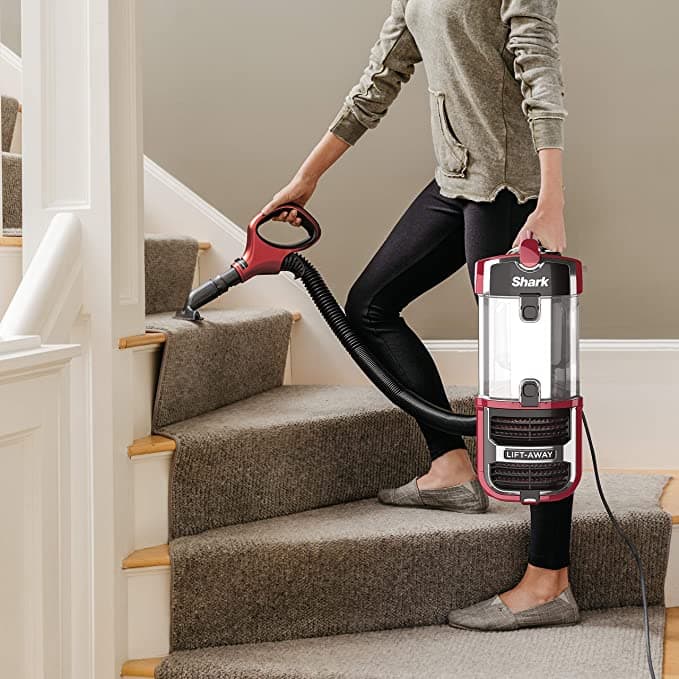
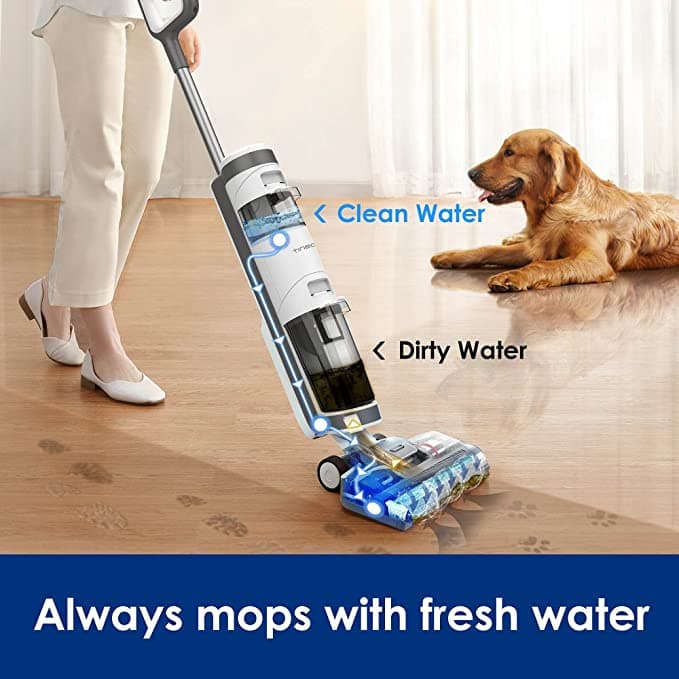
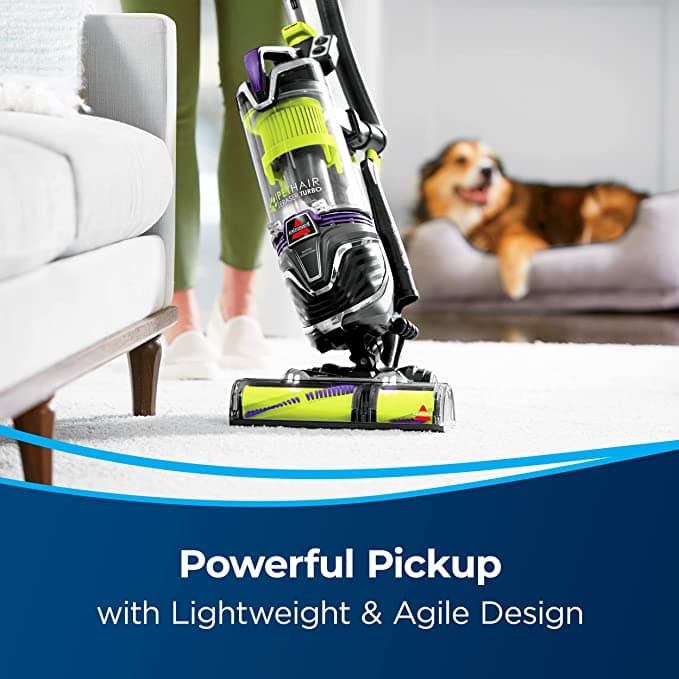
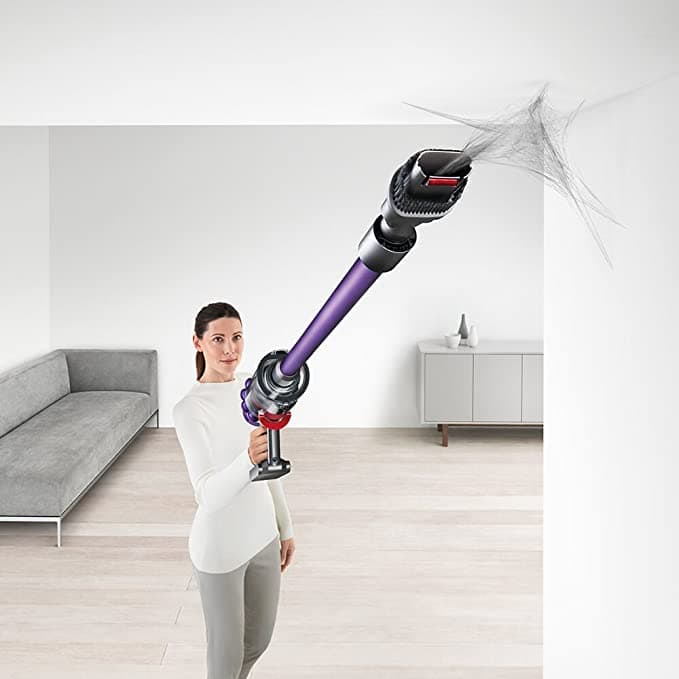
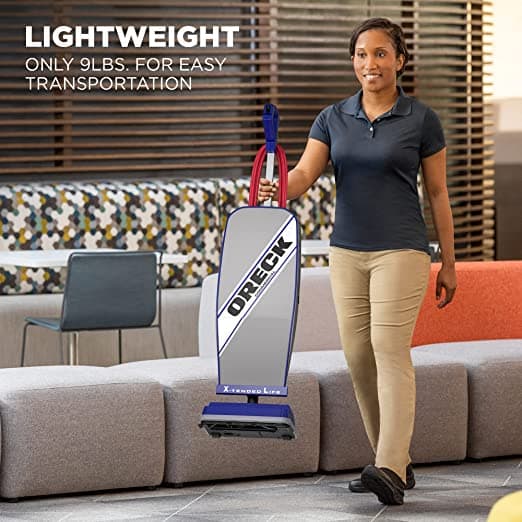

Anything in the $100 range that would be suitable?
Under 100 I’m not aware of any with a completely sealed system, but I’d take a look at this one which should be right around $100, is pretty effective, and has a HEPA filter.
My wife and I have been frustrated at seeing all of the dust and dirt build up on our floors. We love the idea of having a central vacuum installed in our home so we can easily keep the house clean. It was interesting to read that this type of installation will have a series of tubing connected to a central motor that will have suction ports throughout the house. This seems like an efficient way of keeping the house clean. [link removed]
Yeah, I don’t see many of these, but it’s definitely a neat concept for someone who knows they’re going to be in their home for a long time, is okay with the expense, and is a severe allergy sufferer. Wish I knew more people with them to get real-life feedback, and I haven’t personally tried one myself.
I would NOT live in a home without a central vacuum. I have severe allergies to pet dander/hair and dust. With our old vacuum (very old style)…the bags were terrible and there wasn’t a HEPA filter. We had a cat and I would have a tremendous time sleeping and was wheezing all night my wife vacuumed. At the peak of the problem, I was on antihistamines, albuterol and lung steriod. I decided to install a central vacuum systme that was a retrofit installation and the canister was in the garage. Within a month…my issues were completely resolved. The bag and exhaust is in the garage. When you think of it, the suction air has to flow through the bag and filter and exhaust to the environment…you will always get some of those micro-particulates into the air…and that’s the stuff that really gets me. We love the central vacuum system system and can’t live without it!